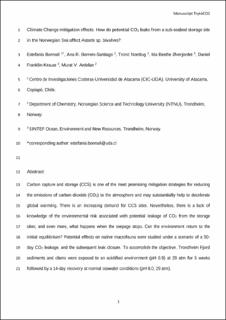| dc.contributor.author | Bonnail, Estefanía | |
| dc.contributor.author | Borrero Santiago, Ana Rocío | |
| dc.contributor.author | Nordtug, Trond | |
| dc.contributor.author | Øverjordet, Ida Beathe | |
| dc.contributor.author | Krause, Daniel Franklin | |
| dc.contributor.author | Ardelan, Murat Van | |
| dc.date.accessioned | 2022-09-20T07:44:22Z | |
| dc.date.available | 2022-09-20T07:44:22Z | |
| dc.date.created | 2020-11-09T15:23:41Z | |
| dc.date.issued | 2021 | |
| dc.identifier.citation | Chemosphere. 2021, 264, 1-12 . | en_US |
| dc.identifier.issn | 0045-6535 | |
| dc.identifier.uri | https://hdl.handle.net/11250/3019024 | |
| dc.description.abstract | Carbon capture and storage (CCS) is one of the most promising mitigation strategies for reducing the emissions of carbon dioxide (CO2) to the atmosphere and may substantially help to decelerate global warming. There is an increasing demand for CCS sites. Nevertheless, there is a lack of knowledge of the environmental risk associated with potential leakage of CO2 from the storage sites; and even more, what happens when the seepage stops. Can the environment return to the initial equilibrium? Potential effects on native macrofauna were studied under a scenario of a 50-day CO2 leakage, and the subsequent leak closure. To accomplish the objective, Trondheim Fjord sediments and clams were exposed to an acidified environment (pH 6.9) at 29 atm for 7 weeks followed by a 14-day recovery at normal seawater conditions (pH 8.0, 29 atm). Growth and survival of clams exposed to pressure (29 atm) and reduced pH (6.9) did not significantly differ from control clams kept at 1 atm in natural seawater. Furthermore, bioaccumulation of elements in the soft tissue of clams did not register significant variations for most of the analysed elements (Cd, Cr, Pb, and Ti), while other elements (As, Cu, Fe, Ni) had decreasing concentrations in tissues under acidified conditions in contrast to Na and Mg, which registered an uptake (Ku) of 111 and 9.92 μg g−1dw d−1, respectively. This Ku may be altered due to the stress induced by acidification; and the element concentration being released from sediments was not highly affected at that pH. Therefore, a 1 unit drop in pH at the seafloor for several weeks does not appear to pose a risk for the clams. | en_US |
| dc.language.iso | eng | en_US |
| dc.publisher | Elsevier | en_US |
| dc.rights | Attribution-NonCommercial-NoDerivatives 4.0 Internasjonal | * |
| dc.rights.uri | http://creativecommons.org/licenses/by-nc-nd/4.0/deed.no | * |
| dc.subject | Shell growth rate | en_US |
| dc.subject | Metal bioaccumulation | en_US |
| dc.subject | CO2 impacts | en_US |
| dc.subject | Astarte sp. | en_US |
| dc.subject | Carbon capture storage risks | en_US |
| dc.title | Climate change mitigation effects: How do potential CO2 leaks from a sub-seabed storage site in the Norwegian Sea affect Astarte sp. bivalves? | en_US |
| dc.type | Peer reviewed | en_US |
| dc.type | Journal article | en_US |
| dc.description.version | acceptedVersion | en_US |
| dc.rights.holder | This is the authors’ accepted and refereed manuscript to the article. This manuscript version is made available under the CC-BY-NC-ND 4.0 license. Open access from 7 October 2022. Published article is available here: https://doi.org/10.1016/j.chemosphere.2020.128552 | en_US |
| dc.source.pagenumber | 12 | en_US |
| dc.source.volume | 264 | en_US |
| dc.source.journal | Chemosphere | en_US |
| dc.identifier.doi | 10.1016/j.chemosphere.2020.128552 | |
| dc.identifier.cristin | 1846253 | |
| dc.relation.project | Norges forskningsråd: 254777 | en_US |
| cristin.ispublished | true | |
| cristin.fulltext | postprint | |
| cristin.qualitycode | 1 | |

